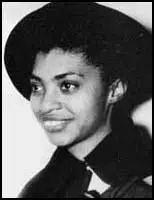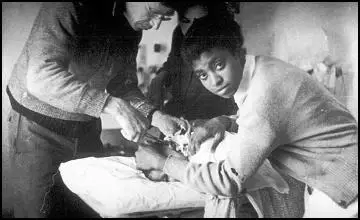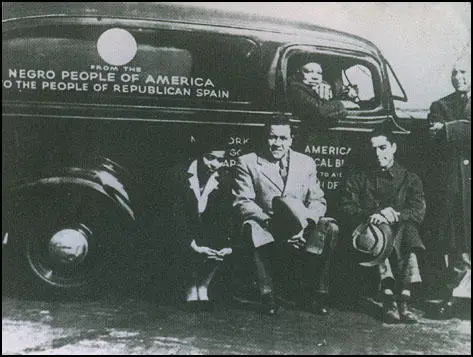Salaria Kea

Salaria Kea was born in Georgia in 1917. Her father, an attendant at the Ohio State Hospital for the Insane, was stabbed to death when Kea was a child. His widow took her four children, including Salaria, to Akron, Ohio.
According to Emily Robins Sharpe: " Kea’s accounts of her childhood and adolescence more frequently focus upon the support and love of her brothers and family friends, who raised her and encouraged her to pursue a nursing degree. Kea had to move to Harlem to do so, because the institutions nearer by were segregated and refused to admit her." Kea became a nurse and while working at the Harlem Hospital School of Nursing, led a successful campaign against racial segregation. After graduation, he became head nurse of Sea View Hospital’s tuberculosis ward in New York City.
It appears that Kea joined the American Communist Party during this period. Although she always denied she was a member telling a journalist that she “thought Communism was for white people only, just like the mafia.” In 1935 she helped to organize medical care in Ethiopia when it was invaded by Italy. She was keen to volunteer as a nurse but Haile Selassie, the emperor, had stopped accepting foreign volunteers.
In March 1937 Kea joined an American Medical Unit working with the Abraham Lincoln Battalion in the Spanish Civil War. She later recalled: "I sailed from New York with the second American Medical Unit. I was the lone representative of the Negro race. The doctor in charge of the group refused to sit at the same table with me in the dining room and demanded to see the Captain. The Captain moved me to his table where I remained throughout the voyage."

Kea helped establish a field hospital at Villa Paz near Madrid. Villa Paz had been the summer home of Alfonso XIII who had abdicated in 1931. She wrote in her diary: "The villa is set in a lavish garden. The peasants attached to the estate, impoverished and illiterate, still lived in the same cramped, poorly lit quarters they had before. In a corner of the usual one-room hut, on top of a tile they burned dried dung from the cattle. This was their only source of heat in rainy and cold weather. They had turned the villa itself over to the cattle."
Kea later argued that the Spanish peasants had attitudes similar to those of African-Americans: "The Spanish peasants had been psychologically just as imprisoned, had accepted the belief that nothing could be done about their situation as had the Harlem nurses earlier accepted racial discrimination in their dining room. Like the Harlem nurses, too, the peasants were now learning that something could be done about it….There was nothing inviolable about the old prejudices…they could be changed and justice established.”
Several black men served in the Abraham Lincoln Battalion including Oliver Law and Harry Haywood. Kea later recalled: "The Negro men who fought for Loyalist Spain never tire of telling how they celebrated when they got news that the Second American Medical Unit included a Negro nurse. Their battalion had been in the trenches 120 days of continuous fighting. I am told that during the entire First World War a fighting unit was never required to be under fire longer than this. Their clothing was shabby and worn. Many had so little to wear they could not appear in public. I was so excited over going to Spain I did not realize that many other Negroes had already recognized Spain's fight for freedom and liberty as a part of our struggle too. I didn't know that almost a hundred young Negro men were already fighting Hitler's and Mussolini's forces there in Spain."While working in Spain she met an injured International Brigades soldier, John Patrick O’Reilly, from Ireland. They fell in love and in her memoirs she wrote, “We discussed North America, Ireland, and all groups and races who were victims of fascism and other injustices and how we two could help to abolish the enemies of the human race.” They married while they were in Spain.

Kea was captured by the Nationalist Army but after being held prisoner for seven weeks she managed to escape. Kea returned to her American Medical Unit but was badly wounded by a bomb while working in a field hospital. Her injuries were so severe she had to return to the United States. Over the next few months she toured the country raising funds and recruiting volunteers to help defend the Popular Front government. In 1938 she published Salaria Kea: A Negro Nurse in Republican Spain.
John Patrick O’Reilly moved to the United States in 1940. He served in the United States Army during the Second World War. In 1944 Kea also worked as a nurse supporting the armed forces. After the war they lived in New York City before moving to Akron. According to Emily Robins Sharpe: "Once back in the United States - and especially in Akron - she and O’Reilly experienced extensive racism in the form of personal threats and property damage: according to various interviews, at certain points they were afraid to leave the house together."
Salaria Kea O'Reilly died on 18th May 1990.
Primary Sources
(1) Salaria Kea O'Reilly, Health and Medicine (Spring, 1987)
I sailed from New York with the second American Medical Unit. I was the lone representative of the Negro race. The doctor in charge of the group refused to sit at the same table with me in the dining room and demanded to see the Captain. The Captain moved me to his table where I remained throughout the voyage.
(2) Salaria Kea, quoted in Women's Voices in the Spanish Civil War (1991)
27 March 1937: I sailed from New York with the second American Medical Unit... I was the lone representative of the Negro race. The doctor in charge of the group refused to sit at the same table with me in the dining room and demanded to see the Captain. The Captain moved me to his table where I remained throughout the voyage...
Official instructions were to set up our hospital at Villa Paz near Madrid. Villa Paz had been the summer palace of King Alfonso XIII, deserted since his abdication in 1931. The villa is set in a lavish garden. The peasants attached to the estate, impoverished and illiterate, still lived in the same cramped, poorly lit quarters they had before. In a corner of the usual one-room hut, on top of a tile they burned dried dung from the cattle. This was their only source of heat in rainy and cold weather. They had turned the villa itself over to the cattle.
(3) Salaria Kea O'Reilly, Health and Medicine (Spring, 1987)
The Second American Medical Unit, authorized by the Republican Government of Spain, at once turned the cows out of Villa Paz, cleaned the building and set up the first American base hospital in Spain.
The beds of Villa Paz were soon filled with soldiers of every degree of injury and ailment, every known race and tongue from every corner of the earth. These divisions of race, creed and nationality lost significance when they met in a united effort to make Spain the tomb of Fascism. I saw my fate, the fate of the Negro race, was inseparably tied up with their fate: the efforts of the Negroes must be allied with those of others as the only insurance against an uncertain future.
The Negro men who fought for Loyalist Spain never tire of telling how they celebrated when they got news that the Second American Medical Unit included a Negro nurse. Their battalion had been in the trenches 120 days of continuous fighting. I am told that during the entire First World War a fighting unit was never required to be under fire longer than this. Their clothing was shabby and worn. Many had so little to wear they could not appear in public.
I was so excited over going to Spain I did not realize that many other Negroes had already recognized Spain's fight for freedom and liberty as a part of our struggle too. I didn't know that almost a hundred young Negro men were already fighting Hitler's and Mussolini's forces there in Spain.
(4) In 1938 the Medical Bureau and North American Committee to Aid Spanish Democracy in New York published Salaria Kea: A Negro Nurse in Republican Spain.
The hospital beds were soon filled with soldiers of every degree of injury and ailment, of almost every known race and tongue and from every corner of the earth. Czechs from Prague, and from Bohemian villages, Hungarians, French, Finns. Peoples from democratic countries who recognized Italy and Germany's invasion in Spain as a threat to the peace and security of all small countries. Germans and Italians, exiled or escaped from concentration camps and fighting for their freedom here on Spain's battle line. Ethiopians from Djibouti, seeking to recoup Ethiopia's freedom by strangling Mussolini's forces here in Spain. Cubans, Mexicans, Russians, Japanese, unsympathetic with Japan's invasion of China and the Rome-Berlin-Tokyo axis. There were poor whites and Negroes from the Southern States of the United States. These divisions of race and creed and religion and nationality lost significance when they met in Spain in a united effort to make Spain the tomb of fascism. The outcome of the struggle in Spain implies the death or the realization of the hopes of the minorities of the world.
Salaria saw that her fate, the fate of the Negro Race, was inseparably tied up with their fate; that the Negro's efforts must be allied with those of other minorities as the only insurance against an uncertain future. And in Spain she worked with freedom. Her services were recognized. For the first time she worked free of racial discrimination or limitations.
There were not too many skilled hands to make the wounded comfortable. Everybody's services were conscripted. Nurses taught carpenters to make hospital supplies - shock blocks, back rests, Balkan frames for fractured arms, Fire and fuel they needed desperately.

